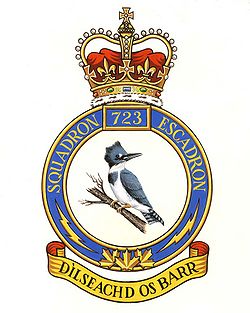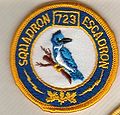723 (Halifax) Communication Squadron
|
| 723 Communication Squadron | |
|---|---|
 | |
| Active | - 2011 |
| Garrison/HQ | Halifax Nova Scotia |
| Nickname | 723 Comm Sqn |
| Motto | DILSEACHD OS BARR (Loyalty Above ALL) |
723 Communication Squadron was absorbed by 36 Signals Regiment by Ministerial Order dated 26 July 2011[1]
History
History taken from "www.723finalfling.com" (site no longer exists)
723 Communication Squadron can be traced back almost to the inception of the Canadian Signals Corps. On 24 October 1903 General Order 167 authorized the formation of the Canadian Signals Corps. The first independent Signals Corps in the British Empire. In 1904 with the issue of Militia Order No. 45, dated 24 February 1904, authorized the signals corps an establishment of 90 all ranks. This included 18 officers and 72 NCM’s, which was broken down to 1 signals officer 6 signalmen and 7 enlisted personnel per militia district.
Militia District No. 9 covered Nova Scotia. No. 9 Signals Section Halifax was first commanded by Provisional Lieutenant W.C. Proudfoot. He can be considered the units first Commanding Officer. Records have been hard to find but No. 9 Signal Section Halifax remained the same until April 1911.
In April 1911, four military commands and military districts 1 to 9 and 12 were reorganized to form six divisional areas based on a British model. With in these six divisional areas only four Signal Companies were formed: No. 1 Signal Company London, Ontario; No. 2 Signal Company Toronto, Ontario; No. 3 Signal Company Kingston, Ontario; and No. 6 Signal Company Halifax, Nova Scotia. Captain T.E. Powers was appointed the Commanding Officer of No. 6 Signal Company. The headquarters was located in Halifax but sub units were deployed throughout the region including: Woodstock, Saint John, Salt Springs and Charlottetown. This organization lasted until after World War I.
On 6 August 1914, General Order 172 authorized the formation of 1 Canadian Division Signals Company. On August 20 1914, the company began forming in Valcartier for overseas deployment. This Company was brought up to strength by drafts from 1, 2, 3 1nd 6 Signal Company’s. The 1st Division Signal Company reached the Western Front on 15 Jan 1915. Through the war 4 Divisional Signal Companies were formed, Major T.E. Powers commanded the 3rd Divisional Signal Company in France.
After the war the reorganization of the Non Permanent Army Militia (NPAM) began in the 1920’s. The Dominion of Canada was divided into 11 Military Districts with one Signal Battalion for each plus two fortress Companies in Halifax and Vancouver, seven troops and 19 Signal Companies. Nova Scotia comprised of Military District 6. Halifax became 6 Fortress Signal Company. On 1 April 1936 this unit became Supplementary to Eastern Fortress Establishment. As of 3 September 1939, written in an order for battle which listed District 6 Signals Permanent Force as No. 6 Detachment Halifax with its NPAM as No. 6 Fortress Signal Company Halifax.
During World War II, 6 Fortress Signal Company helped with the defence of Halifax and Eastern Approaches. This however did not limit personnel from volunteering for overseas duty and members helped to augment Signals units that went overseas. As the war progressed responsibilities developed and in 1941 fortress signals transformed into Area Signal Companies under Atlantic Command Signals, Royal Canadian Corps Signals. No. 6 Signal Company was located in Halifax. Communications facilities were built across the Maritimes to support all units assigned to the defence of the East Coast. All this construction also provided valuable experience for reinforcements to Europe.
After the war between 1945 and 1948 the active component of the signal unit was reorganized to become Eastern Command Signal Regiment, the reserve component became East Coast Signal Regiment. East Coast Signal Regiment had a HQ in Halifax with 1 Area Signal Squadron in Halifax, 2 Area Signal Squadron in Saint John and No. 4 Troop 1 Area Signal Squadron located in Glace Bay. In the 1950’s discussions were held and it was recommended by the Signals Association and reserve Commanding Officers that all units should reflect the same Regimental Model. Hence the renaming of the Regiment to, 6th Signal Regiment Halifax, in 1960. In 1956 Glace Bay was reduced to nil strength and in 1960 St John became independent. The unit moved into the Cogswell Street Barracks in 1949, and again to the Halifax Armouries in 1953 where is still resides today.
In 1965 was the formation of Canadian Forces Communication Systems (CFCS) and in 1968 was the unification of the Canadian Forces. Through all these changes the militia suffered huge budget cuts in 1965 and like many other units the 6th Signal Regiment HQ was retired to the supplementary order and 1 Area Signal Squadron Halifax remained. Even with the cuts training remained the same. In 1970 CFCS became official and was now called Canadian Forces Communication Command (CFCC). All signal reserves were now under the Command of CFCC rather than the Army. This brings us to the formation of the Group Headquarters across Canada with 72 Communication Group taking control of all the Maritime Reserve Communication units. 723 Communication Squadron Halifax as we all know has been created.
In 2008 the Communication Reserve began its transformation back to the Army after almost 40 years. After a few ideas being thrown around like Operational Support Groups (OSG’s) a decision was made that by September 2010 the Group Headquarters would dissolve and each Brigade Group would form a Signal Regiment. Halifax was to become 36 Signal Regiment with a Headquarters in Halifax and its sub units being comprised of 721 Communication Regiment Charlottetown, 723 Communication Squadron Halifax and 725 Communication Squadron Glace Bay. Squadron naming has yet to be determined.
September 2010 has come and gone, 723 Communication Squadron is still officially an independent unit, 72 Communication Group Headquarters still exists. 36 Signal Regiment, 72 Comm GP and 723 are all awaiting for the official signing of paperwork (CFOO and MOO). This process could take over a year, and until then there is an implementation team in place located at group that makes up the HQ of 36 Sig Regt. The current situation is somewhat confusing but some official duties do run through 36 Sig Regt and some still run through 72 Comm Gp.
| Unit lineage | ||
|---|---|---|
| Preceded by No. 1 Signal Squadron |
723 (Halifax) Communication Squadron - 2011 |
Succeeded by 36 Signal Regiment |
Related Pages
Related Items
See Also
- ↑ Ministerial Organization Order 2011055, 26 July 2011.

